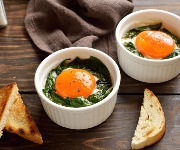How to prepare fish
Fish is a fantastic source of protein and should be a key part of our weekly diet. But it's not easy to prep like a pro. Fish novice Urvashi Roe fights her phobia of fish preparation under the watchful eye of Head Chef, Lee Groves.
I was raised as a vegetarian and despite the fact that my home state of Gujarat in India has a huge coastline, fish did not feature in my diet. Growing up in the UK and travelling all over the world, I developed a fascination for fish and slowly started trying it. I had lots of criteria. It had to be cooked, not raw. It could only be white fish as that was least offensive on my immature taste buds. It could certainly not be on the bone so I had to see innards and bones. And finally there could be no scales or eyes. That would just be terrifying.
I bought fish in its various fresh and frozen pre-packaged forms from supermarkets because I was too scared to walk into a fishmonger. All those eyes and scales! I hadn’t a clue about preparing fish and was reluctant to learn. Handling uncooked fish threw me into panic attacks.
Facing my fishy fear
Enough is enough. I decided it was high time I faced this ridiculous phobia. I wanted to really understand what I was eating. I know that some fish supplies are dwindling and wanted to be more responsible for my choices.
So the first stop had to be a fish market. And so while visiting Cornwall I took the opportunity for a guided tour of Newlyn fish market by Andy Wheeler from the Cornish Fish Producers Organisation.
It was a cold, early, start and I was already nervous about seeing all the dead fish. We walked from crate to crate as Andy explained the different species and how they were caught. I was squeamish at first but what struck me was that there was no fishy smell. This made it much easier to concentrate on his explanations of mesh sizes and recovery plans, collaborative efforts between fishermen and scientists to regulate stocks. These hard working fishermen were moving to the top of my honorable people list already.
I came away with my head spinning with varieties I wanted to add to the list such as ling, hake, gurnard and ray wings.
The basics of fish preparation in eight steps
I was no longer scared of looking at a dead fish so now the challenge was to touch it. Under the instruction of former Masterchef Professional Semifinalist Lee Groves, I learned all the basics of fish preparation. He showed us different types of fish and talked through the basics of fish anatomy. He demonstrated how to cut the head off, take the fish off the bone, and remove the bones and the skin. He made it look so easy and by the time I found the courage to put my hand up and have a go, he was holding up a mackerel. The one I was most terrified of. But even my daughters were having a little prod and a poke so I found the bravado and got stuck in.
Step 1: Slit the belly in the middle. I thought this would be the hardest part but the knife was so sharp, this was quick and required very little effort from me.
Step 2: Scoop out the innards. I really did feel a little vomit rising as my shaking fingers picked more so than scooped the guts out. My hands were not covered in blood as I had expected but the feel of the cold innards was making me nauseous.
Step 3: Wash out the cavity. I breathed a sigh of relief at the sink as all the wobbly bits washed away and my fingers were left clean and untainted with fish guts.
Step 4: Cut the head off just under the fins. This was easy. I wished I could have done it at the start to get rid of the bright, beady eyes staring at me.
Step 6: Take the side off by sliding the knife along the bone. By this point, I just wanted to be done with this fish and save as much as possible for eating so I concentrated on keeping the knife along the top bone. It took me a while to conquer this as I didn’t like the way the knife felt along the flesh.
Step7: Pick off all the bones. The hardest part was done and the bones came off easily. It was like plucking stray eyebrow hairs.
Step 8: Slide the skin off. I had expected to push the flesh off the skin but Lee advised it was better to pull the skin from side to side so the fish came easily off the knife blade. It was hard work keeping the knife steady and wiggling the skin the right way.
I was incredibly proud of myself and the great thing was that I used the basic steps above for almost all of the fish and shellfish we ate that day. Even the enormous 35 year old lobster that I proudly picked up was prepared by chopping off the head, slicing the body in half and scooping out the flesh for cooking. A few less innards which was a relief.
Inconceivable recipes are now in my weekly repertoire
Most of the fish cooking I’ve done before has been chopped chunks in a sauce of some kind. I’m delighted that I can now prepare a fish for previously inconceivable ceviche or a pan fry recipes. Or indeed, leave the fish whole now I’m clear on how to remove the head and skin and knowing where the bones are going to be.
My confidence grows each time I pick up a fish and am no longer afraid to step into the fishmongers and ask for different varieties. I’m still squeamish about the eyes and coral but now I at least know how to remove them.
Get hands on yourself
If you’d like to learn more about preparing fish there are courses across the country at Cookery School in London, Ashburton Cookery School in Devon, Seasoned Cookery School in Derbyshire and Edinburgh Cookery School for example. If you’d like a more relaxed long weekend of seafood, try The Food and Travel Company.
Also worth your attention
Top five fish recipes from around the world
A day in the life of a fish farmer
You might also like:
Top five fish recipes from around the world
Most Recent
Comments
Be the first to comment
Do you want to comment on this article? You need to be signed in for this feature








